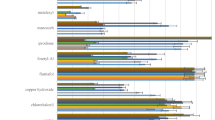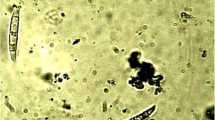Abstract
Tobacco crop is affected by false broomrape caused by phytopathogenic isolates belonging to the Nocardia genus, present in the soil. Both persistence and incidence levels of its causal agent are lower in soils with red to reddish tonalities. These tones are associated with the presence of oxidized iron forms. The aim of this research was to assess the antimicrobial potential of different chemical forms of iron on phytopathogenic isolates of Nocardia sp., and evaluate its effect on the symptom expression of false broomrape in tobacco plants. Susceptibility to iron salts of four isolates was assessed in vitro by the minimal inhibitory concentration test. In in vivo experiments, soil inoculated with phytopathogenic isolates was treated with FeSO4.7H2O and symptom expression of false broomrape was evaluated as the average degree of affection, which considers grades of growth of tumours and buds developed on roots. We found that phytopathogenic isolates from four tobacco areas of Cuba with high incidence of the disease showed in vitro susceptibility to free iron in its oxidized forms of Fe+2 and Fe+3. It was shown that the application of 1000 ppm of FeSO4.7H2O on the roots of tobacco seedlings and in the soil where they were transplanted reduces expression of the symptoms of false broomrape.


Similar content being viewed by others
References
Acevedo-Sandoval O, Ortiz-Hernández E, Cruz-Sánchez M, Cruz-Chávez E (2004) Papel de óxidos de hierro en suelos. Terra Latinoamericana 22:485–497
Agrios G (2010) Fitopatología. 2a ed. Editorial Limusa SA, México City
Aitkenhead M, Coull M, Towers W, Hudson G, Black H (2013) Prediction of soil characteristics and colour using data from the National Soils Inventory of Scotland. Geoderma 200:99–107
Albano J, Merhaut D (2012) Influence of Fe-EDDS, Fe-EDTA, Fe-DTPA, Fe-EDDHA and FeSO4 on marigold growth and nutrition, and substrate and runoff chemistry. HortScience 47:93–97
Badía D, Martí C, Palacio E, Sancho C, Poch R (2009) Soil evolution over the quaternary period in a semiarid climate (Segre river terraces, northeast, Spain). Catena 77:165–174
Bartáková I, Kummerová M, Mandl M, Pospisil M (2001) Phytotoxicity of iron in relation to its solubility conditions and the effect of ionic strength. Plant and Soil 235:45–51
Borowski E (2013) Uptake and transport of iron ions (Fe+2, Fe+3) supplied to roots or leaves in spinach (Spinacia oleracea L.) plants growing under different light conditions. Acta Agrobotanica 66:45–52
Broschat T, Moore K (2004) Phytotoxicity of several iron fertilizers and their effects on Fe, Mn, Zn, Cu, and P content of African marigolds and zonal geraniums. HortScience 39:595–598
Brown-Elliott B, Killingley J, Vasireddy S, Bridge L, Wallace R (2016) In vitro comparison of ertapenem, meropenem, and imipenem against isolates of rapidly growing mycobacteria and Nocardia by use of broth microdilution and Etest. Journal of Clinical Microbiology 54:1586–1592
Buhr T, Sobota L, MacKie R, Slaterbeck A (2005) Decontamination of biological microbes using metal cations suspended in ethanol. U.S. patent application no 11/250691
Cadahía LC (2005) Fertirrigación: cultivos hortícolas, frutales y ornamentales. Mundi-Prensa, Madrid
Chang H, Lai J, Wang J (2016) The minimum inhibitory concentration of antibiotics against Nocardia seriolae isolation from diseased fish in Taiwan. Taiwan Veterinary Journal 42:81–84
Expert D, Franza T, Dellagi A (2012) Iron in plant–pathogen interactions. In: Expert D, O’Brian MR (eds) Molecular aspects of iron metabolism in pathogenic and symbiotic plant–microbe associations. SpringerBriefs in Molecular Science. Springer, Dordrecht
Fones H, Preston GM (2013) The impact of transition metals on bacterial plant disease. FEMS Microbiology Reviews 37:495–519
Hata T, Maruoka T (2001) Bactericide containing iron ions. U.S. patent no 6296881
Hernández A, Pérez-Jiménez JM, Bosch D, Castro N (2015) Clasificación de los suelos de Cuba 2015. Ediciones INCA, La Habana
IUSS Working Group WRB (2014) World reference base for soil resources 2014. World soil resources reports no. 106. FAO, Rome
Kalantari N (2008) Evaluation of toxicity of iron, chromium and cadmium on Bacillus cereus growth. Iranian Journal of Basic Medical Sciences 10:222–228
Kuswantoro H (2014) Relative growth rate of six soybean genotypes under iron toxicity condition. International Journal of Biology 6:11–17
Lucas GB (1975) Diseases of tobacco. Biological Consulting Associates, Raleigh
Méndez R (1998) Característica, distribución y daños del falso Orobanche en el cultivo del tabaco. MSc Dissertation, Universidad Central de Las Villas "Marta Abreu", Villa Clara
Monzón L, Trémols AJ, Álvarez L, Villalón A, Chávez L (2015) Acumulación de cloro en respuesta a restricciones hídricas. Cuba Tabaco 16:3–8
Morán YM, Chacón O, Córdoba-Selles MC, Domínguez R, Herrera Isla L, Borrás-Hidalgo O (2013) Identification and molecular characterization of Nocardia sp. as a new causal agent of tobacco false broomrape. Journal of Phytopathology 161:86–91
Morán YM, Pérez JL, Núñez A, Domínguez-Larrinaga R, Torrecilla G, Córdoba-Selles MC, Herrera-Isla L (2015a) Evaluación de la resistencia al falso Orobanche causado por Nocardia sp. en Nicotiana spp. Cultivos Tropicales 36:108–116
Morán YM, Trémols AJ, Domínguez-Larrinaga R, Carballo RM (2015b) Relación entre las propiedades físicas y químicas de los suelos y la manifestación del "falso Orobanche" en Cuba. Cuba Tabaco 16:27–41
Mulu A, Tessema B, Derbie F (2004) In vitro assessment of the antimicrobial potential of honey on common human pathogens. Ethiopian Journal of Health Development 18:107–111
Oyarzúa-Alarcón P, Sossa K, Contreras D, Urrutia H, Nocker A (2014) Antimicrobial properties of magnesium chloride at low pH in the presence of anionic bases. Magnesium Research 27:57–68
Prescott LM, Harley JP, Klein DA (2009) Microbiología. 7a Ed. McGraw-Hill Interamericana de España SAU, Madrid
Rath KM, Maheshwari A, Bengtson P, Rousk J (2016) Comparative toxicity of salts to microbial processes in soil. Applied and Environmental Microbiology 82:2012–2020
Rout GR, Sahoo S (2015) Role of iron in plant growth and metabolism. Reviews in Agricultural Science 3:1–24
Schaad NW, Jones JB, Chun W (2001) Laboratory guide for identification of plant pathogenic bacteria. APS Press, St Paul
Sorokina EV, Yudina TP, Bubnov IA, Danilov VS (2013) Assessment of iron toxicity using a luminescent bacterial test with an Escherichia coli recombinant strain. Microbiology 82:439–444
SPSS Inc. (2009) PASW statistics for windows. Version 18.0. SPSS Inc., Chicago
Sutton S (2011) Measurement of microbial cells by optical density. Journal of Validation Technology 17:46–49
Trémols AJ, Cánepa Y, Álvarez L (2013) Efecto del fungicida clorotalonilo sobre la acumulación de cloro en las hojas de tabaco Negro var. Corojo 99. Cuba Tabaco 14:67–69
Umapriya R, Shrihari S (2010) Pathogen removal under the influence of iron. International Journal of Environmental, Chemical, Ecological, Geological and Geophysical Engineering 4:690–695
Valdezate S, Garrido N, Carrasco G, Medina-Pascual M, Villalón P, Navarro A, Saéz-Nieto J (2016) Epidemiology and susceptibility to antimicrobial agents of the main Nocardia species in Spain. Journal of Antimicrobial Chemotherapy 72:754–761
Zhao P, Zhang X, Du P, Li G, Li L, Li Z (2017) Susceptibility profiles of Nocardia spp. to antimicrobial and antituberculotic agents detected by a microplate Alamar Blue assay. Scientific Reports 7:43660
Zorzi P, Barbizzi S, Belli M, Ciceri G, Fajgelj A, Moore D, Sansone U, Van Der Perk M (2005) Terminology in soil sampling (IUPAC recommendations 2005). Pure and Applied Chemistry 77:827–884
Acknowledgements
Our thanks to Dr. Nóra Mendler-Drienyovszki (Research Institute of Nyíregyháza, University of Debrecen, Hungary) and to Dr. Vivian Marlene Izaguirre-García (University of San Carlos, Guatemala) for their special contribution as critical reviewers of the manuscript.
Author information
Authors and Affiliations
Corresponding author
Additional information
Section Editor: Marcelo Carmona
Rights and permissions
About this article
Cite this article
Morán-Gómez, Y.M., Trémols-González, A.J., Domínguez-Larrinaga, R. et al. Assessment of antimicrobial potential of iron on phytopathogenic isolates of Nocardia sp. and their effect on tobacco false broomrape symptom expression. Trop. plant pathol. 43, 333–340 (2018). https://doi.org/10.1007/s40858-018-0213-5
Received:
Accepted:
Published:
Issue Date:
DOI: https://doi.org/10.1007/s40858-018-0213-5




